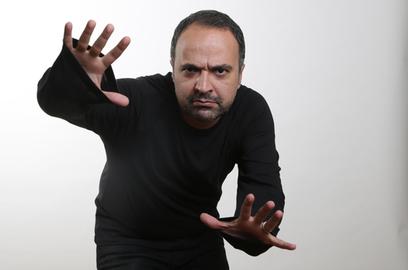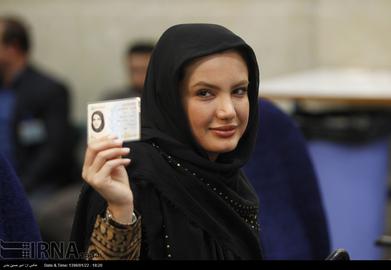In this series on self-censorship, we asked writers, artists, journalists and human rights activists to define self-censorship. Where possible, they are invited to give examples of their experiences, and to describe what they have witnessed.
We presented each interviewee with the same set of questions, adapting them or asking further questions where relevant.
Our intention was for the interviewees to express their own perspective of self-censorship.
***
Kambiz Hosseini is a satirist, television and radio host, actor, theater director and playwright. Before leaving Iran in 2000, he was active in theater and on TV and radio. He is now the host of a satirical news program on Radio Farda, the Persian Language service of Radio Liberty/Free Europe. In 2015 Hosseini won a silver award at New York Festivals International Radio Program Awards for his weekly program Five in the Afternoon.
Our interview with Mr. Hosseini will be published in two parts. In the first part, he discusses the censorship and self-censorship he experienced as a student, and his later experience with theater in Iran.
How do you define self-censorship?
Like anybody else, my definition comes from my personal experience — an experience that taught me how to survive the cultural and artistic environment of Iran through self-censorship, and how to prevent being sidelined.
I believe that self-censorship is a kind of weapon for creative people, for writers, artists, journalists or anybody else. People use this weapon to survive in the system and to avoid being pushed aside. For an artist, this is an important sign of life. Self-censorship might be a reprehensible tool that should have never existed, but it is the tool one can use to prevent being eliminated completely.
You think this tool and using it to survive in an ideological system is something positive?
No, never. It is like participating in a competition where sometimes you have to stop to prevent from being run over. Using this tool in a country like Iran is mandatory. I do not agree with those who say restrictions lead to creativity. I believe that without restrictions people are more creative. There are those who believe that the limitations that [the film director Abbas] Kiarostami had to deal with after the revolution made his genius blossom. I don’t believe this and there is no doubt that he still would have been a genius had he lived in a free society.
Is self-censorship an example of social misconduct or prudence?
If it is done for survival then it is prudence, like when a journalist lives in Iran and makes a living this way. He cannot write whatever he wants because it will not be published. He has to work in the framework set for him. In my work, as with working for any media, there are restrictions — but [elsewhere] the levels do not have the same depth and breadth as in Iran. In Iran it is not human or work standards but ideological ones [that have an impact], and it is the enforcement of ideology that is excruciatingly painful.
Iran is a self-censoring society. Is this self-censorship rooted in Iranian culture or in its history and political events?
The Iranian regime has imposed a new line of thought on people, and on the whole society. No doubt before the revolution there were other kinds of self-censorship. From a historical point of view, we must take into account invasions that we have suffered throughout history — like the Arab or Mongol invasions. When you live in a place that is not safe, when you have grown up in an unsafe environment and at every moment feel the threat of an attack, then your first instinct is to think about your survival.
We Iranians are good at working individually, but are weak at teamwork. I think one reason is that we have always lived in fear of others attacking us. For us Iranians, survival comes first. Everything else comes after survival. But to survive you have to give up things to gain other things. We have managed to survive with self-censorship. We want to stay alive and perhaps this is one reason for self-censorship [existing throughout] Iranian history.
Naturally if the person who commits self-censorship is intelligent and perceptive, he immediately recognizes that it is not a good thing. Not just perhaps but most definitely, it is a painful moment for a writer who wants to write something but does not write it, when he wants to say something but does not say it.
When I was in Iran I worked mostly in theater. When I was a student, censorship and self-censorship were a kind of entertainment for us in playwriting classes. We tried to show how people fall in love, or how they kiss so that the audience would understand that the two protagonists were kissing, without staging it in a way that would not be allowed.
If you are in Iran and want to exhibit your work or stage your play, you have two ways to avoid entanglements. You either give in to self-censorship or effectively commit suicide. For example, at a festival, you can stage your play exactly as it is, without implementing “amendments,” for one time only, and then forget about staging it anywhere else outside the festival. They called the censorship that they imposed on us in theater “amendments” and used to say they were not very significant because people had left such problems behind.
Self-censorship and censorship in theater, whether in Iran or anywhere else in the world, is a stupid thing. Why? Because the art of the theater allows you to say what you want to say by using metaphors. If we look at the movies of the 1980s, we see how they applied censorship to the most ordinary interactions between a man and a woman. For example, on the first night of their marriage the lovers enter the bedroom. The man takes off his jacket or coat. The woman is kept out of the frame and the camera moves towards a window with its curtain twisting in the wind. Then the camera leaves the room through the window and — if the movie was made by a director like Ali Hatami and he had the means — the camera moves towards the pool, a pomegranate falls into the pool or a dove soars into the sky from next to the pool. All this shows the resistance practiced by the artists of that decade. This resistance shows they did not give in to censorship. On the other hand, the audience is also intelligent: it notices censorship and self-censorship when it sees them. In the past few decades, the only thing that has not been respected is the audience’s intelligence.
For Iranian artists, self-censorship has always been a tool to escape excessive scrutiny so they can carry on with their work until it can be performed or presented. Self-censorship is like hijab. A woman might be against wearing hijab, but must first wear it so she can step outside her home and participate in social and civic activities. This is how self-censorship works. First you must be able to present your work. It is only afterward that people can learn whether you agree, disagree or have any views at all. If you are an Iranian woman and do not wear hijab then you cannot step outside your home. If you are an Iranian writer and do not self-censor then you cannot publish and present your work.
visit the accountability section
In this section of Iran Wire, you can contact the officials and launch your campaign for various problems

























comments
SELF CENSORSHIP IS DESIGNED TO CONTROL SOCIETY,,BUT I BELIEVE IT IS SELF DESTRUCTIVE AND HISTORY BARES TESTAMENT TO THAT,THE WORLD AND KNOWLEDGE WILL NOT ALLOW A COUNTRY TO BUILD A WALL AROUND IT AND KEEP ITS PEOPLE IN,AND ALL THE WORLD OUT IT'S ONLY A FOOLISH DREAM FOR THE SMALL MINDED EXTREMIST WHO TRY TO HOLD ONTO POWER AND CONTROL IN THEIR COUNTRY. ... read more